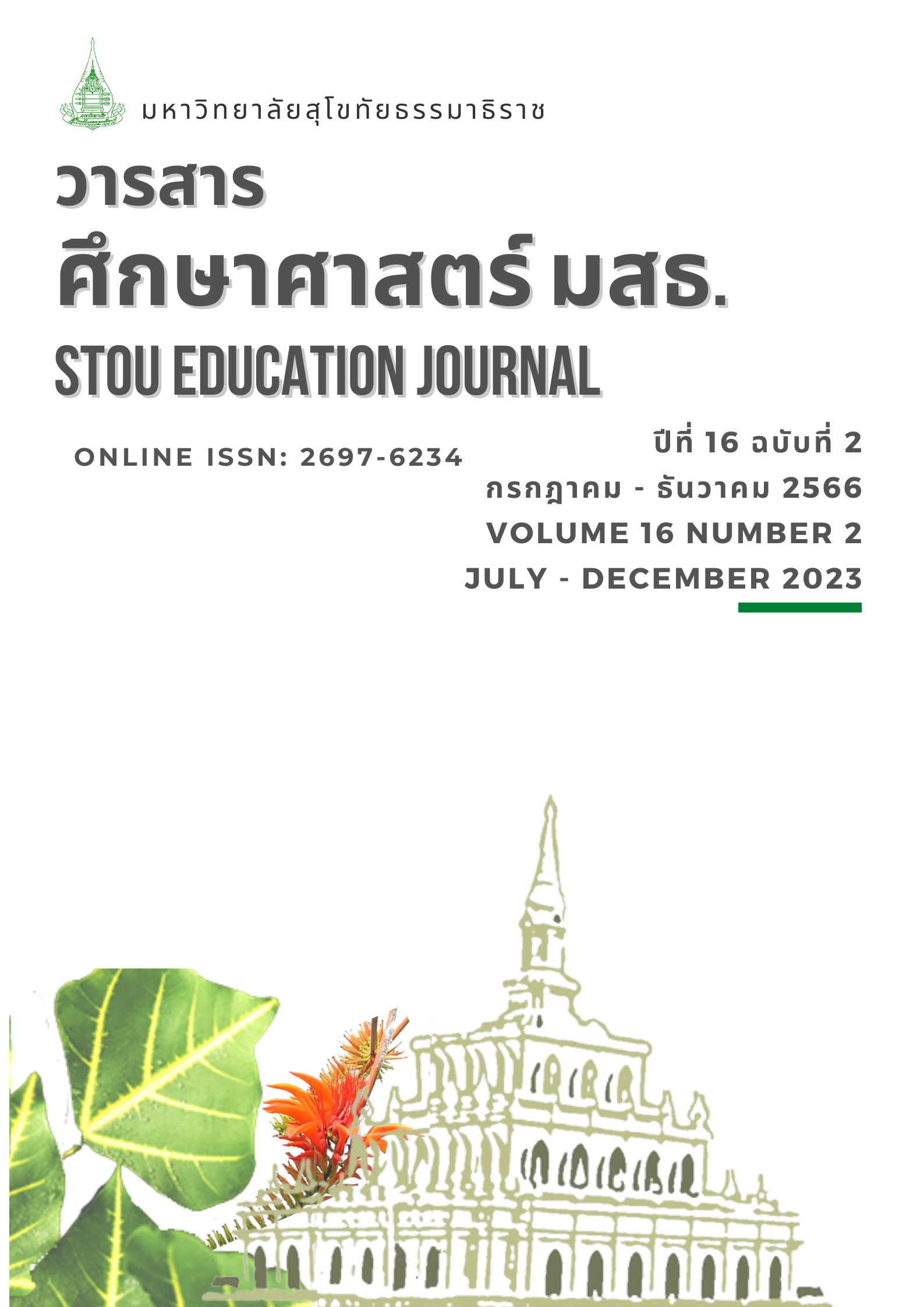A Study of Management on Non-Degree Programs and Credit Bank Systems of Sukhothai Thammathirat Open University and Open Universities in Asia
Main Article Content
Abstract
The present study aimed to study studied the management of non-degree programs and credit bank systems and propose related policies. Phase 1 studied the management of non-degree programs and credit bank systems. The participants were chief executives, lecturers, officers, and university students including the study of document of 5 open universities. The research instruments were questionnaires and recording forms. Phase 2 examined the proposed policies regarding the management development of non-degree programs and credit bank systems. The participants were experts, lecturers, officers, and university students. The research tool was a guided focus group interview. The research revealed that 1) the management of non-degree programs and credit bank systems of STOU was generally at a high level. This included a strong technological infrastructure and the use of various information media. Policies and organizational arrangements were clear, and the curriculum and teaching methods align with the needs of the students. While the management of non-degree programs and credit bank systems of the other open universities in Asia demonstrated that each university has established responsibilities based on the government’s guidelines that helped promoting the life-long learning policy. In phase 2, (1) some of the proposed policies in relation to the management of non-degree programs were as follows: (1.1) The universities should adopt a national policy to enhance lifelong learning. (1.2) The universities should determine the target groups for non-degree curriculums that cover all ages. (2) some of the proposed policies on the management of the credit bank system were: (2.1) The government should establish standard qualification frameworks for universities to use as a reference for knowledge and experience transfer. (2.2) The government should create agencies to oversee the standards for knowledge and experience transfer, and (2.3) There should be committees responsible for monitoring and evaluating the performance of operations at all levels.
Article Details
References
กระทรวงการอุดมศึกษา วิทยาศาสตร์ วิจัยและนวัตกรรม. (2563). อว. ลงนามความร่วมมือ MOU กับ 19 มหาวิทยาลัย เปิดหลักสูตรเพิ่มทักษะรองรับงานหลังวิกฤติ COVID-19 http://www.ops.go.th/main/index.php/news-service/news-executive/2181-mou-19-covid-19
กองแผนงาน งานสารสนเทศยุทธศาสตร์. (2565). รายงานสารสนเทศ ประจำปีการศึกษา 2564.มหาวิทยาลัยสุโขทัยธรรมาธิราช.
แนวทางการดำเนินงานคลังหน่วยกิตในระดับอุดมศึกษา พ.ศ. 2565 (2565, 24 พฤศจิกายน). ราชกิจจานุเบกษา. เล่มที่ 139. ตอนที่ 273 หน้า 28-31.
พงษ์ภิญโญ แม้นโกศล. (2564). ผลการทดลองใช้ระบบธนาคารสะสมหน่วยการเรียนรู้ของสถาบันการอาชีวศึกษาในจังหวัดตาก. วารสารบรรณศาสตร์ มศว., 14(1), 15-27.
มหาวิทยาลัยสุโขทัยธรรมาธิราช. (2565ก, 2 พฤษภาคม). ประกาศมหาวิทยาลัยสุโขทัยธรรมาธิราช เรื่อง หลักเกณฑ์และวิธีการเทียบผลการศึกษาและเทียบประสบการณ์ เข้าสู่ชุดวิชาในหลักสูตรระดับบัณฑิตศึกษา พ.ศ. 2565.
___________________. (2565ข, 2 พฤษภาคม). ประกาศมหาวิทยาลัยสุโขทัยธรรมาธิราช เรื่อง หลักเกณฑ์และวิธีการเทียบผลการศึกษาและเทียบประสบการณ์เข้าสู่ชุดวิชาในหลักสูตรระดับปริญญาตรี พ.ศ. 2565.
___________________. (2565ค, 2 พฤษภาคม). ประกาศมหาวิทยาลัยสุโขทัยธรรมาธิราช เรื่อง หลักเกณฑ์และ วิธีการจัดการเรียนการสอนระดับต่่ากว่าปริญญาในระบบโมดูลการสอนทางไกล พ.ศ. 2565.
สำนักงานคณะกรรมการการอุดมศึกษา. (2551). กรอบแผนอุดมศึกษา ระยะยาว 15 ปี ฉบับที่ 2 (พ.ศ 2551-2565).โรงพิมพ์แห่งจุฬาลงกรณ์มหาวิทยาลัย.
สำนักงานคณะกรรมการพัฒนาเศรษฐกิจและสังคมแห่งชาติ. (2566). แผนพัฒนาเศรษฐกิจสังคมแห่งชาติ ฉบับที่ 13 พ.ศ. 2566 -2570. https://www.nesdc.go.th/main.php?filename=plan13
สำนักงานเลขาธิการสภาการศึกษา. (2563ก). ศึกษาการศึกษาและพัฒนาระบบและกลไกการขับเคลื่อนระบบธนาคารหน่วยกิต: ข้อเสนอสำหรับประเทศไทย. พริกหวานกราฟฟิค.
_______________. (2563ข). ระบบธนาคารหน่วยกิตและกลไกขับเคลื่อน: ความเชื่อมโยงระหว่างภาคอุดมศึกษากับภาคแรงงาน/ภาคประกอบการ.พริกหวานกราฟฟิค.
อรุณี ตระการไพโรจน์. (2561). ระบบธนาคารสะสมผลการเรียนรู้ สำหรับการศึกษาตลอดชีวิตของประเทศไทย.[วิทยานิพนธ์ศึกษาศาสตรดุษฎีบัณฑิต ไม่ได้ตีพิมพ์]. มหาวิทยาลัยธุรกิจบัณฑิตย์.
Benham, P. (1999). Challenges and trends in HR/IR: Bridging the gap for global competitiveness. Advanced Management Journal, 64, 9–14.
Haddad, W. D. (2006). Higher education and the dynamics of globalization. Association of Biblical Higher Education International Conference.
Li, H., Sun, Y., Yang, M., & Wei, Z. (2013). The establishment of academic credit accumulation and transfer system: A case study of Shanghai Academic Credit Transfer and Accumulation Bank for Lifelong Education. Asian Association of Open Universities Journal, 8(1), 61-70.
Ministry of Education, Science and Technology (2010, April). Academic credit bank system. http://english.mest.go.kr/web/1710/en/board/enview.do?bbsId=258&boardSeq=1227& mode=view


